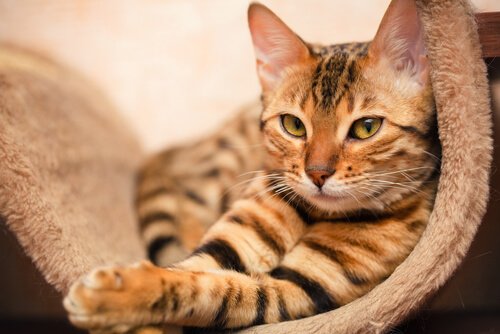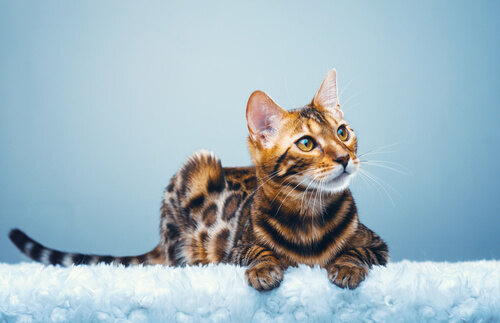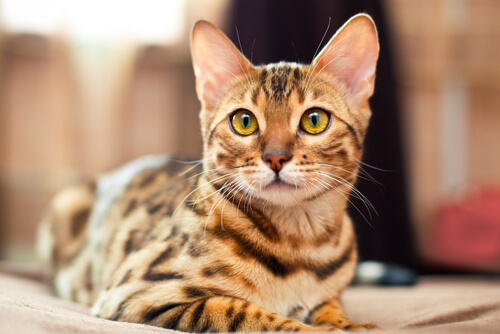Bengal Cats - A Very Special Crossbreed

Bengal cats are a cross between domestic cats and the Asian leopard cat. Originating from the US, people consider this breed to be a hybrid and it stands out for its beautiful dappled coat.
History of the Bengal cat
At first glance, you could be forgiven for thinking the Bengal really is a wild cat. This is because it was first bred back in 1963, after someone crossed a male domestic cat with a female Asian leopard cat. The name comes from the Asian leopard cat’s taxonomic name: Prionailurus bengalensis.
While they might share the same name and be distant relatives, this breed is not directly descended from the Bengal tiger. As we have already mentioned, its wild ancestor is the leopard cat, which lives in various countries of South East Asia: Cambodia, China, Thailand, Malaysia, Philippines and Indonesia.
The aim of mixing these wild cats with domestic cats was to produce an animal that had the exotic look of the leopard cat, with the docile temperament of the domestic cat. The first time this breed really grabbed the spotlight was in 1985, when its striking appearance caused a sensation in the cat world.

While it might sound strange, the Bengal cat is a great swimmer – a unique quality in a domestic cat. This is actually an inherited genetic trait, passed down by its wild ancestors.
Bengal cats: physical characteristics
As for its physical characteristics, the Bengal cat is robust and muscular, with a dense, heavy bone structure. They are large animals, the males weighing up to 20lb. The females, on the other hand, often measure only half this size.
Their tails are thick, and their heads are wide and round in shape. They also have long noses, strong jaws, and long limbs which give them a slender, athletic look.
Their ears are relatively small, while their almond eyes are a bright yellow-green color. Their fur is one of their most distinctive characteristics. Bengal cats usually have short, thick, mottled brown fur dappled with spots (or rosettes). The base coat can be orange-brown, beige, gold or yellow, while the markings can be chocolate, black or cinnamon. Finally, the tip of its tail is always black.
In fact, it is its stunning coats that makes the Bengal cat so popular. After all, one of the main aims in breeding these cats was to create an animal with an attractive coat.
Bengal cats: behavior
With its boundless energy, curiosity, and constant desire to play, you might feel like you really do have a miniature leopard in your house. However, Bengals really are the perfect pets: intelligent and affectionate, and often creating far closer relationships with their owners than other breeds.
It’s not unusual for Bengals to follow their owners around the house, wait at doors or windows for them to come home, sleep next to them in bed at night, or snuggle up at their side for protection and warmth.
Today’s Bengals are the result of several generations of breeding, and are in many ways exactly like other domestic cats, well-accustomed to contact with humans.

The mothers are usually well-socialized at the time their kittens are born. Like their mothers, the kittens grow up in an ordinary home.
They don’t “revert back” to their wild behavior (at least, no more than any other cat). Like with all felines, the breeding season can be problematic, however this can quickly be resolved by neutering your cat.
These intelligent and curious cats will get into everything – nothing can stay hidden from them for long. They are really sociable creatures, and have no trouble getting on with other pets, whether cats or dogs.
The Bengal cat is the perfect combination of wild and domestic. They can get frightened easily, but they’re extremely affectionate. They are also very playful, running madly around the house and climbing on furniture.
If you have other cats in the house, they’ll soon become inseparable, and will undoubtedly get into all sorts of adventures (and trouble) together.